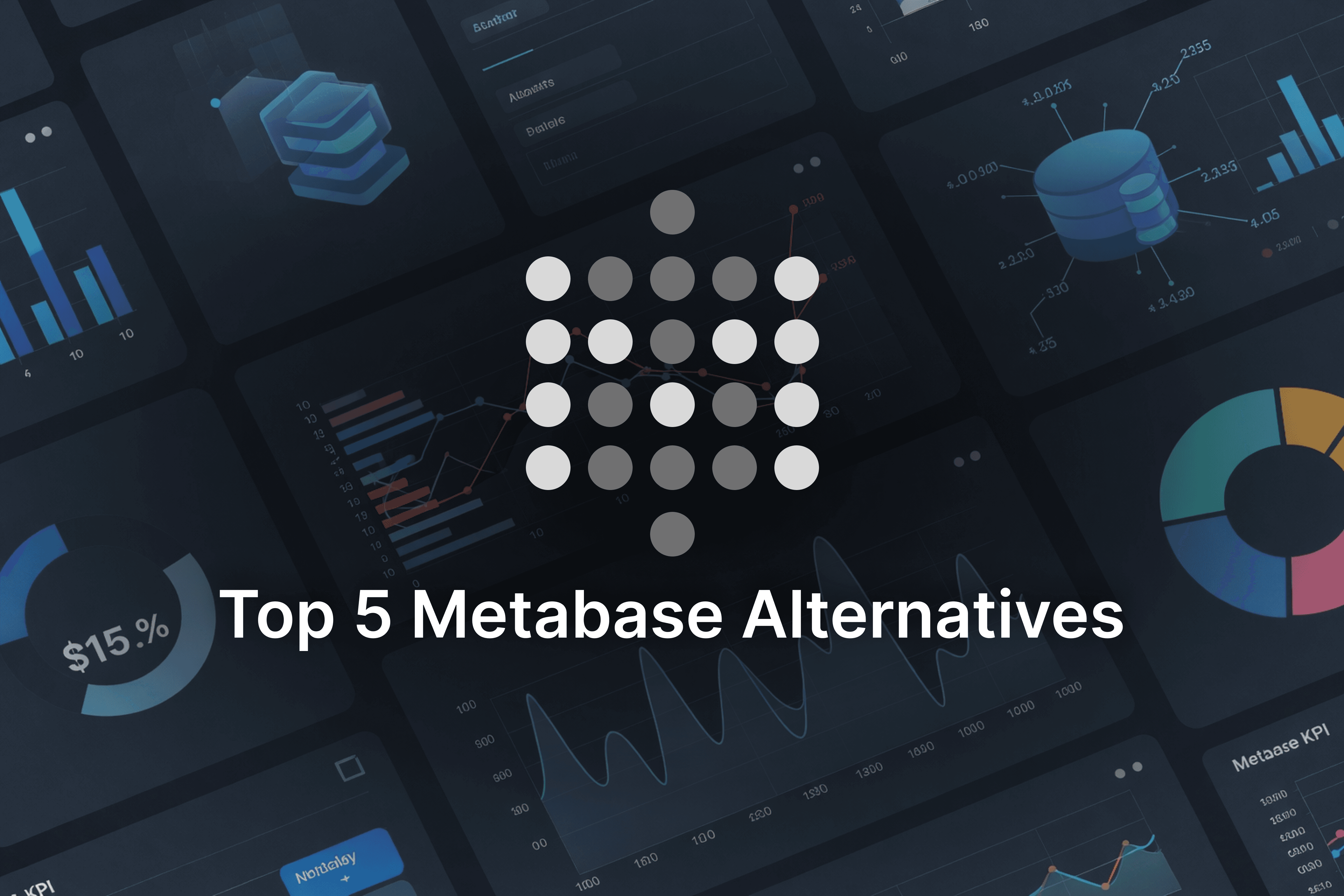Due to growing volumes of data, Business Intelligence (BI) platforms have become crucial for organizations in today's data-centric world. The importance of BI platforms lies in their ability to transform raw data into actionable insights, empowering businesses to optimize operations, enhance productivity, and drive strategic growth.

Metabase is one of the most popular business intelligence tools for internal reporting. However, as analytics move closer to end users and products, many teams find Metabase’s embedded analytics capabilities increasingly limited.
This guide explores 5 proven Metabase alternatives for embedded analytics, breaking down their pros and cons, real-world use cases, and how they compare to Metabase, helping you choose the right platform for scalable, customer-facing analytics.
Why Metabase Falls Short for Embedded Analytics
Metabase works well for internal dashboards, but it struggles with true embedded analytics in SaaS products, where native UX, scalability, security, and deep customization are essential for customer-facing use cases.
Iframe-based embedding: Dashboards load inside iframes, creating non-native experiences, slower performance, cross-domain issues, and poor mobile responsiveness.
Limited customization & white-labeling: Full UI control is restricted, making it difficult to align analytics with a product’s brand and design system.
Weak embedding controls: User-level permissions, row-level security, and multi-tenant data isolation require complex workarounds.
Scalability limitations: Performance degrades as data volumes grow and concurrent embedded users increase.
High developer dependency: Advanced embedding, maintenance, and scaling demand ongoing engineering effort instead of no-code flexibility.
Because of these limitations, many businesses are switching to no-code, AI-driven embedded analytics platforms that offer fully white-labeled dashboards, interactive insights without SQL, real-time collaboration, and deeper integrations with modern data warehouses.
What Is Embedded Analytics (and Why It Matters in 2026)?

Embedded analytics is the practice of integrating data analysis, dashboards, and insights directly into a software application or website, allowing users to explore and act on data within the product itself, without switching tools or interfaces.
Example: A SaaS company showing real time customer churn data inside its admin panel, so account managers don’t switch tools to make decisions.
In 2026, embedded analytics is critical because:
Data complexity is increasing
Customers expect real-time answers
No-code and AI tools are enabling non-technical users
Businesses want data where the action happens
1. Supaboard: Best AI-Powered No-Code Alternative to Metabase
Supaboard is an AI-powered, no-code Metabase alternatives that enables SaaS companies and enterprises to embed fully white-label analytics dashboards, generate automated insights, and deliver real-time analytics, without SQL or heavy developer involvement.
Pros
AI generates dashboards instantly, no SQL required
No-code drag and drop builder for business & product teams
Rich white label embedding with branding controls
Real time collaboration & commenting
Robust data governance & permissions
Cons
Newer entrant, expanding customization features
Focused on SaaS & SMBs (enterprise features growing)
Metabase vs Supaboard
Ease of Use: Supaboard’s no-code builder beats Metabase’s SQL-heavy setup for non-technical teams
Embedding: Supaboard.ai offers seamless white-label embedding, while Metabase relies on iframes
AI Insights: Automated insights reduce manual report creation by up to 60%
Use Case Example:
An enterprise team used Supaboard to connect multiple databases, ask data questions, achieve 98% insight accuracy, and reduce reporting and analysis time by 60% across teams.

2. Tableau: Enterprise Grade Analytics
Tableau is an enterprise-grade alternative to Metabase built for advanced data visualization, large-scale analytics, and complex reporting, commonly used by organizations needing deep customization and enterprise-level analytical capabilities.
Pros
Huge visualization library with advanced customization
Handles complex, large-scale datasets
Extensive integration options
Cons
Steep learning curve
Higher pricing
Embedding requires dev resources
Metabase vs Tableau
Scale: Tableau outperforms Metabase for enterprise-scale deployments
Customization: Tableau allows deep visual customization; Metabase is more basic
Cost: Tableau is significantly more expensive
Use Case:
A multinational used Tableau to embed financial dashboards across 5,000+ employees, leveraging its complex data blending capabilities.
3. Microsoft Power BI: Best for Microsoft Ecosystem
Microsoft Power BI is a popular Metabase alternative for Microsoft-centric teams, enabling interactive dashboards, embedded analytics, and seamless integration with Excel, Azure, and other Microsoft services.
Pros
Affordable (especially for O365 users)
Native integration with Excel, Teams, and Azure
Solid embedding features
Cons
UI complexity for beginners
Embedding needs some dev work
Metabase vs Power BI
Integration: Power BI dominates for Microsoft-heavy companies
Cost: Comparable or cheaper than Metabase for O365 users
Embedding: Slightly more flexible than Metabase’s iframe
Use Case:
An enterprise embedded Power BI inside Dynamics 365, giving sales teams live KPI access without switching apps.
4. Apache Superset: Open Source Powerhouse
Apache Superset is a fully open-source alternative to Metabase that provides highly customizable dashboards and SQL-driven analytics for technical teams seeking flexibility and full control over data visualization.
Pros
100% free and open-source
Highly customizable dashboards
Active community
Cons
Requires strong SQL/engineering skills
Less polished UX than paid tools
Metabase vs Superset
Cost: Both offer free versions, but Superset is fully open-source
Flexibility: Superset offers more customization, but requires technical effort
UX: Metabase is easier for non-technical users
Use Case:
A startup embedded Superset into internal tools for full query control without vendor lock-in.
5. Redash: Developer-Friendly SQL Analytics
Redash is a developer-friendly Metabase alternative focused on fast SQL querying and lightweight dashboards, ideal for engineering teams that prioritize speed, simplicity, and embedded analytics over no-code features.
Pros
Fast, minimal SQL dashboard creation
Open-source with hosted options
Great for quick data exploration
Cons
Minimal no-code features
Limited visual customization
Metabase vs Redash
Speed: Redash is faster for dev-heavy teams
No-Code: Metabase has more business-friendly features
Embedding: Similar iframe limitations in both
Use Case:
A SaaS engineering team built Redash dashboards to track feature adoption within 48 hours of release.
Quick Comparison: Metabase vs Top Alternatives
Tool | Ideal For | Ease of Use | Embedding Method | Pricing | Standout Feature |
|---|---|---|---|---|---|
Startups, SMBs, SaaS | ⭐⭐⭐⭐⭐ | White-label, no-code | Mid-tier | AI-powered instant dashboards | |
Tableau | Enterprises | ⭐⭐⭐ | API, JS SDK | High | Advanced visualizations |
Microsoft Power BI | Microsoft ecosystem users | ⭐⭐⭐⭐ | iFrame, API | Low | Deep Microsoft integration |
Apache Superset | Tech teams | ⭐⭐ | Custom embedding | Free | Fully open-source |
Redash | Developers | ⭐⭐ | Basic iframe | Low | Fast SQL dashboarding |
What to Look For When Choosing an Embedded Analytics Tool

No-Code / Low-Code Capabilities: Reduce dependency on SQL
AI Insights: Get instant anomaly detection & forecasting
Integration Coverage: Works with your warehouse & SaaS stack
Collaboration Features: Live comments, tagging, sharing
Branding & White-Label Options: Keep analytics on-brand
Frequently Asked Questions (FAQ)
1. What is the best alternative to Metabase?
Supaboard is one of the best Metabase alternatives, offering AI-powered no-code dashboards, automated insights, and fully white-label embedded analytics. It’s ideal for SaaS and enterprise teams needing scalable, customer-facing analytics without SQL.
2. Is there a no-code alternative to Metabase?
Yes, tools like Supaboard and Tableau provide no-code or low-code analytics experiences. Supaboard allows users to build dashboards using natural language and drag-and-drop tools, while Metabase depends more on SQL-based querying.
3. Which Metabase alternative is best for embedded analytics?
Supaboard is a leading Metabase alternative for embedded analytics, offering native white-label embedding, granular permissions, and low developer dependency. Power BI also supports embedding but generally requires more complex technical setup.
4. Is Metabase good for enterprise analytics?
Metabase suits small to mid-sized teams, but enterprises often choose Supaboard, Tableau, or Power BI for better scalability, stronger governance, advanced embedding features, and AI-driven analytics built for large-scale usage.
5.How to Choose the Right Embedded Analytics Solution?
When choosing an embedded analytics solution, look beyond dashboards. Prioritize native embedding over iframes, strong white-labeling, and role-based security. Ensure it scales with growing users and data, supports no-code or AI-driven insights, and integrates seamlessly with your existing data stack.
Conclusion & Next Steps
Metabase remains a solid entry-level BI tool, but in 2026 the expectations for embedded analytics platforms have evolved. Businesses now demand seamless embedded analytics, AI-driven insights, and no-code dashboards that deliver value directly inside products.
Among Metabase alternatives, Supaboard stands out for its AI-powered, no-code embedded analytics and full white-label capabilities. Tableau and Power BI are strong choices for large enterprises, while Apache Superset and Redash suit developer-centric analytics setups.
The right choice depends on your scale, users, and embedded analytics requirements.
Pro Tip: Before deciding, create a feature checklist based on your use case, then trial at least 2–3 tools side-by-side.
Ready to see AI dashboards in action? Book a Supaboard.ai demo today.









